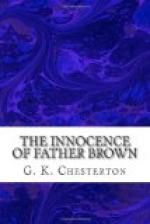The white lightning opened its enormous eye in one wink, the sky shut up again, and the priest went on:
“Of all these crooked things, the crookedest was the shape of that piece of paper. It was crookeder than the dagger that killed him.”
“You mean the paper on which Quinton confessed his suicide,” said Flambeau.
“I mean the paper on which Quinton wrote, `I die by my own hand,’” answered Father Brown. “The shape of that paper, my friend, was the wrong shape; the wrong shape, if ever I have seen it in this wicked world.”
“It only had a corner snipped off,” said Flambeau, “and I understand that all Quinton’s paper was cut that way.”
“It was a very odd way,” said the other, “and a very bad way, to my taste and fancy. Look here, Flambeau, this Quinton—God receive his soul!—was perhaps a bit of a cur in some ways, but he really was an artist, with the pencil as well as the pen. His handwriting, though hard to read, was bold and beautiful. I can’t prove what I say; I can’t prove anything. But I tell you with the full force of conviction that he could never have cut that mean little piece off a sheet of paper. If he had wanted to cut down paper for some purpose of fitting in, or binding up, or what not, he would have made quite a different slash with the scissors. Do you remember the shape? It was a mean shape. It was a wrong shape. Like this. Don’t you remember?”
And he waved his burning cigar before him in the darkness, making irregular squares so rapidly that Flambeau really seemed to see them as fiery hieroglyphics upon the darkness—hieroglyphics such as his friend had spoken of, which are undecipherable, yet can have no good meaning.
“But,” said Flambeau, as the priest put his cigar in his mouth again and leaned back, staring at the roof, “suppose somebody else did use the scissors. Why should somebody else, cutting pieces off his sermon paper, make Quinton commit suicide?”
Father Brown was still leaning back and staring at the roof, but he took his cigar out of his mouth and said: “Quinton never did commit suicide.”
Flambeau stared at him. “Why, confound it all,” he cried, “then why did he confess to suicide?”
The priest leant forward again, settled his elbows on his knees, looked at the ground, and said, in a low, distinct voice: “He never did confess to suicide.”
Flambeau laid his cigar down. “You mean,” he said, “that the writing was forged?”
“No,” said Father Brown. “Quinton wrote it all right.”
“Well, there you are,” said the aggravated Flambeau; “Quinton wrote, `I die by my own hand,’ with his own hand on a plain piece of paper.”
“Of the wrong shape,” said the priest calmly.
“Oh, the shape be damned!” cried Flambeau. “What has the shape to do with it?”
“There were twenty-three snipped papers,” resumed Brown unmoved, “and only twenty-two pieces snipped off. Therefore one of the pieces had been destroyed, probably that from the written paper. Does that suggest anything to you?”




